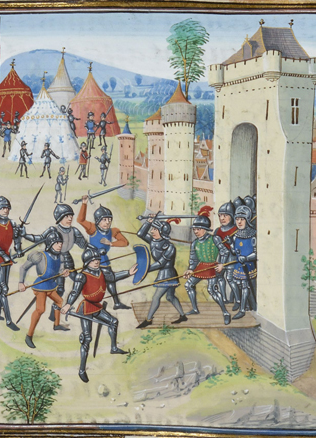The Underwater World of the Dead
Historical sources and archaeological data indicate that the Balts used to bury the deceased in the earth, burned or unburned, in the 13th and 14th centuries. Recent archaeological findings, however, provide surprises revealing earlier unknown burial rituals, such as underwater sepulchre of the dead after first burning them down.
A grave at the bottom of a lake
It was in 1983 that the remains of the burned dead bodies and shrouds were discovered and examined for the first time in the Lake Obeliai, in the region of Ukmergė. Scientists found about 2,400 different items and their fragments in a fairly small area of the bed of the lake, including weapons, adornment, and household articles. The ten-metre long and three-metre wide stone pavement led from the shore and into the water. According to the chief researcher, Vytautas Urbanavičius, the 13–15th century items discovered in the lake represent the remains of the underwater tombs. It is very likely that burned bodies of the deceased would be carried along the stone pavement to eventually leave them on the bed of the lake.
The Lake Vilkumuiža, situated in the historical Curonian land that is now Latvia, also provided abundant archaeological findings. Back in 1934, archaeologists hauled up a total of 1,300 items dating from the 10th to the 14th century and weighing a total of 85 kilograms. No tiny burned particles of bones have been found there because the archaeologists used scoop-nets and small boats in their work. The scientists maintain than the Lake Vilkumuiža was the place where people used to dispose the remains of the burial fire, the findings being offerings.
The buried treasuries
Over the past several years, archaeologists have been excavating the burial site in the location called Bajorai in the vicinity of the town of Elektrėnai. They believe that the small mound where the remains of burned bones and other objects have been found was a shallow part of a lake in the 14th century. The remains of the burned corpses, together with fragments of brass and iron items as well as shards of the ornamented ceramics, are believed to have been scattered on top of the underwater mound or at its base. The burial ground features at least several dozen men, women and children of different age and social status.
The findings, which include the first-type Lithuanian coin, cross- and rhombus-shaped pendants, round and horseshoe-shaped tin and cast brooches, a holder made of a bear’s claw, pouch decorations, fragments of a hacked silver ring, thrown ornamented ceramics etc, suggest that the Bajorai burial site dates back to the end of the 14th and the first half of the 15th century.
Another 14th century underwater burial ground is believed to have been found just 500 metres south from the Kernavė mounds, in the now dried up old bed of the Kernavė Rivulet where about 13 kilograms of burned human and animal bones, thrown ceramics and other burned 14th century findings have been unearthed. The Jagiellonian Denar found there is from 1387–1390. It is likely that the remains of the burned bones and shrouds have been deposited into the then running rivulet.
An unsolved mystery
The abovementioned examples of underwater burial have prompted numerous scientific hypotheses and guessing. The explorers of the Lake Obeliai argue that the non-traditional way of sepulchre is related to the retreat of Prussians and Skalvians, vanquished by the Crusaders, to the inner lands of Lithuania. Another theory maintains that the tombs located on the shore of the lake were dug off and dumped into the water at the end of the 14th century, in the wake of the Christianisation of the country. Some scientists have doubts as to whether the remains of the burned bones found on the bed of the lake belong to humans at all as no anthropological examination had been carried out. Hence, the findings in the Lake Obeliai are believed to have been an offering.
The investigators of the burial ground in Bajorai offer yet another hypothesis. They claim that after the Christianisation of the country in 1387, the new religion started spreading around, the pagan rites being its first and foremost enemy while the old societies strived to keep up to their traditions. It was by burning their dead and burying them underwater that the people might have intended to preserve the generations-old customs and to keep away from burying their dead in the Christian earth.
Drowned into Oblivion
What other theories can be made up to explain the ritual of burying of the pre-burned corpses underwater in the 14th century or as late as the beginning of the 15th century? It might sound strange but there are no historical sources of the time to have depicted the customs of that kind. There’s not a single evidence of the underwater burial in the earlier Baltic or prehistoric cultures in the neighbouring countries.
The mythological layers and folklore provide certain barely tangible connections between water and the world of the dead, but the dominating image is always that of mound of manes.
It is the historical reality of the time rather than the centuries-old conservative burial traditions that should provide the answers. The underwater burial is to be considered as a collective one. It eradicates any chance of tomb personification.
The surviving relatives will never be able to pray at such a grave.
This looks quite odd bearing in mind that eastern Lithuania is well known for its mound-building tradition that lasted for the entire millennium. Scientists believe that every separate family would have its own post-mortem “house”, a huge pile of earth several metres in diameter. Quite differently, the mass graves in the ground or under water usually suggest the simultaneous death of several persons. One possible cause of that is pretty obvious in the eastern part of Lithuania at the turn of the 15th century. These are the times of the massive and most devastating raids by the German Order and the period when the whole of Europe is submerged under the wave of the “black death”—the plague.
Gintautas Vėlius



